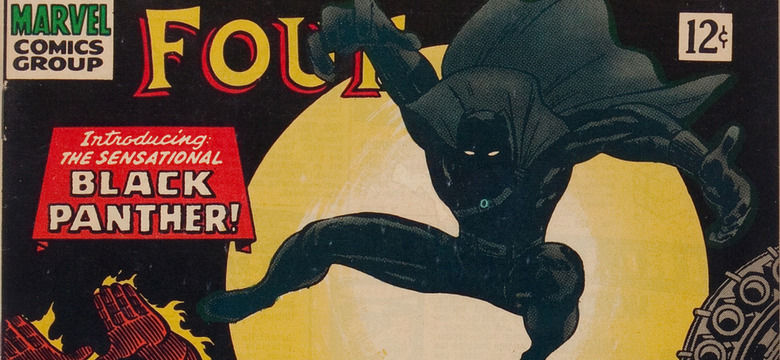“Introducing the Sensational Black Panther!”
That was the cover blurb on Fantastic Four #52 in 1966 … and sensational he was. A fantastic creation from the head of Jack Kirby, refined by the writing of Stan Lee.
Introduced in the movie Captain America: Civil War, in which he fought with and against many of Marvel’s movie icons, there was an immediate buzz around the Black Panther. This year he gets his own solo movie, and it is set to blow the doors off the box offices!
In the mid-1960s, almost everything that poured out of Fantastic Four became yet another lynchpin or cornerstone in the Marvel Universe. The Black Panther appeared in FF #52 through FF #54, and was followed immediately by the introduction of both the Silver Surfer and Galactus in that title, making it a very fertile period for the Lee/Kirby dream team.
So what has made Black Panther such a standout character in the first place?
The Black Panther, whose real name was T’Challa, was the first mainstream superhero from Africa, where he was the King of Wakanda, a secretive high-tech sovereign country in Africa. He was similar in parts to both Lee Falk’s The Phantom and Marvel’s own Iron Man, and yet he was different from both, in part because of his use of super-science technology, and also because of his access to a previously unknown metal called Vibranium. But despite his intelligence and scientific prowess, he still tended to fight hand-to-hand with a lithe skill and physical prowess akin to that of his namesake feline jungle cat. In short, he was a mix of many things, and therefore could not be put into any standard superhero box.
This also makes him the first superhero of color for either of the big two publishers (Marvel and DC), pre-dating the Falcon, Luke Cage, John Stewart (Green Lantern) and Black Lightning.
Black Panther popped up again two years later to team up with Captain America in Tales of Suspense #97-99, and that story led to T’Challa joining the Avengers in issue #52. He appeared regularly in the Avengers up through issue #88 in 1971.
In 1973, Black Panther received a starring feature in Jungle Action with issue #5. His feature ran until issue #24. Issues #6-18 contained the 13-part “Panther’s Rage” story arc that took two years to tell.
In Captain America #170 (1974), he presented the Falcon with some Wakandan technology in the form of red wings to go with the Falcon’s newer red costume. This significantly changed the character of the Falcon, who teamed up with Captain America – not in a secondary “sidekick” role, but as a bona fide partner.
In later stories, the Black Panther entered into the political and cultural fray, and deeper into science fiction when he faced off against the Ku Klux Klan, gained possession of the mystical time-shifting artifacts known as “King Solomon’s Frogs” and eventually even married Storm of the X-Men.
A character with so much important history leaves a trail of key issues and great artwork, and Heritage Auctions has many pieces of that trail in our upcoming Signature auction and some of the weekly auctions:
His first appearance in Fantastic Four #52 in 9.6 CGC condition
His second appears in Fantastic Four #53 in 7.5 CGC condition
His third appearance in Fantastic Four #54 in 9.0 CGC condition
The page on which Black Panther agrees to join the Avengers in issue #52.
The origin of the Black Panther, as told in Avengers #87 in 9.6 CGC condition
Black Panther #1, with the story of King Solomon’s Frogs, in 9.8 CGC condition.
There also are 14 animation Production Cels from the Fantastic Four cartoon featuring Black Panther
Written by: Weldon Adams Weldon Adams is a published comic book historian with 35 years of experience working in the comic book industry. He is also an advisor for the Overstreet Comic Book Price Guide. Currently, he is the comic book art specialist in the cataloging department for Heritage Auctions.
